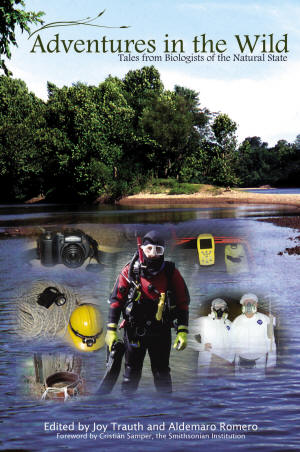University
Communications
Office
Arkansas State University
Jonesboro,
Arkansas
Staff
Markham Howe
Sara McNeil
(870) 972-3056
fax (870) 972-3069
More information:
NewsPage
Links to News Releases
& Announcements
Campus Calendar
Public activities at ASU
Campus News
Faculty and Staff
achievements
About
ASU
Overview, history
and more |
ASU biology faculty publish, launch book on
adventures in field biology April 28
April 15, 2008 --
A new book by Arkansas
State University biology faculty is being published. “Adventures in the
Wild: Tales from Biologists of the N atural
State” will make its debut on the ASU campus on Monday, April 28, at 2
p.m., in ASU’s Hall of Science, Laboratory Sciences Center, East Wing,
117 S. Caraway Road, on the ASU-Jonesboro campus. The book will be
unveiled for the public with many of its authors on hand for a
book-signing ceremony. Dr. Dan Howard, vice chancellor for Academic
Affairs and Research at ASU, will preside over the ceremony, which is
free and open to the public. atural
State” will make its debut on the ASU campus on Monday, April 28, at 2
p.m., in ASU’s Hall of Science, Laboratory Sciences Center, East Wing,
117 S. Caraway Road, on the ASU-Jonesboro campus. The book will be
unveiled for the public with many of its authors on hand for a
book-signing ceremony. Dr. Dan Howard, vice chancellor for Academic
Affairs and Research at ASU, will preside over the ceremony, which is
free and open to the public.
The book is the brainchild of Dr. Aldemaro Romero, chair of
the Department of Biological Sciences and professor of biology at ASU.
Romero says, “The idea occurred to me that most people, including
undergraduate students, have a very incomplete (if not inaccurate) idea
of how biologists really do their work. So I decided to put together a
book with the stories of the incredible things that have happened to
faculty members of the Biology Department at ASU.”
All of these stories, written by the faculty members themselves, are
accounts of true events that occurred in the course of the authors’
fieldwork. Contributing authors are Dr. Jim Bednarz, wildlife ecology;
Dr. Alan Christian, zoology; Dr. John Harris, biology; Dr. David
Gilmore, biology; Dr. Richard Grippo, environmental biology; Dr. Tanja
McKay, entomology; Dr. Fabricio Medina-Bolivar, plant metabolic
engineering; Dr. Tom Risch, environmental biology; Dr. Aldemaro Romero,
biology; Dr. Stan Trauth, zoology; and Dr. Staria Vanderpool,
botany. Some authors contributed more than one chapter.
The preface of the book was written by Dr. Cristian Samper, currently
acting secretary of the Smithsonian Institution in Washington, D.C. and
former director of the Smithsonian Institution’s National Museum of
Natural History. The book was edited by Dr. Aldemaro Romero and Joy
Trauth, instructor in biology.
“I asked Joy
Trauth to help edit the book with me, since she is such a fine writer
and could provide excellent guidance with the more popular type of
writing that a book like this required, especially with the involvement
of so many authors,” Romero noted. “Thus, I sent out an invitation to
the faculty of the department. Most of them replied, sending me their
ideas for their stories. With those, I approached the University of
Arkansas Press, and they sent the first draft of the book to several
reviewers who gave a big ‘thumbs up’ to the enterprise.”
The proceeds from this book will go to fund biology initiatives at ASU,
including the development of the Biodiversity Center, which is expected
to become the prime Arkansas museum of natural history, housing more
than a half-million specimens of plants and animals from ASU
collections.
Romero further states, “Because I wanted the book to benefit
the department, I asked, and was granted, by all the authors, their
permission to donate their royalties to the Biodiversity Center
Initiative, a project to build on the ASU campus a center for the
storage, management, and research of the more than 500,000 specimens of
plants and animals in the department's collection. I then asked Dr.
Cristian Samper, then director of the National Museum of Natural History
and currently acting secretary of the Smithsonian Institution in
Washington, to write the preface, and he agreed."
“Adventures in the Wild: Tales from Biologists of the Natural State” not
only reveals how biologists do their work, it also reveals ASU’s biology
professors—they are men and women who get their feet wet and their hands
dirty in their pursuit of knowledge. Sometimes that pursuit has humorous
consequences, and sometimes mistakes are made, but the biologists and
other scientists of ASU are always determined, whether in the field or
in the classroom, to continue learning and to teach what they have
learned.
###
|
